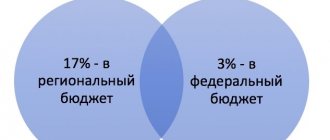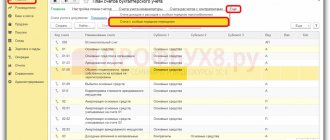Types of securities
In accounting, for the purposes of revaluation, securities are divided into:
- financial investments for which the current market value can be determined (securities listed (admitted for circulation) on the organized securities market);
- financial investments for which the current market value is not determined (securities that are not quoted (not admitted to circulation) on the organized securities market).
Depending on what type of security the security is, the rules for current revaluation and the reflection of its results will be different (revaluation (increase in value), markdown (decrease in value) or the formation of an impairment reserve).
This procedure follows from paragraphs 18–22 and section VI of PBU 19/02.
Listed securities
Quoted securities are accepted for accounting at their original cost. However, at the end of each year, the value of quoted shares must be reflected in accounting and financial statements at the current market value. To do this, you should adjust their assessment as of the previous reporting date, decreasing or increasing it. Revaluations can be done monthly or quarterly. The frequency of revaluation is fixed in the accounting policy of the organization (clause 7 of PBU 1/2008).
This procedure follows from paragraph 20 of PBU 19/02.
Do the revaluation on the basis of official data on quotes (clause 13 of PBU 19/02, letter of the Ministry of Finance of Russia dated March 21, 2005 No. 07-05-06/83). In this case, the organization must use all available sources of information on market prices, including data from foreign organized markets or trade organizers (letter of the Ministry of Finance of Russia dated January 29, 2014 No. 07-04-18/01).
Tip: information on prices (quotations) of securities can be found in the media (newspapers, magazines, Internet, etc.). This data is also provided by the trade organizer or intermediary through whom the securities were purchased.
If on the reporting date the organizer of trading in the securities market does not calculate the market price, then take the latest market price for the current market value of these securities (clause 24 of PBU 19/02 and letter of the Ministry of Finance of Russia dated March 21, 2005 No. 07-05- 06/83).
Reflect the results of the revaluation as a decrease or increase in the initial (book) value of securities and other expenses or income of the organization. To do this, reflect the difference between the new valuation of securities as of the reporting date and their previous valuation on account 58 “Financial investments” in correspondence with account 91 “Other income and expenses”. Make the following entries:
Debit 58 Credit 91-1 – reflects the revaluation of securities;
Debit 91-2 Credit 58 – reflects the markdown (impairment) of securities.
This procedure follows from paragraph 20 of PBU 19/02, paragraphs 7, 10.5 and 16 of PBU 9/99, paragraphs 11 and 14.4 of PBU 10/99 and the Instructions for the chart of accounts (accounts 58 and 91).
When calculating taxes, do not take into account the revaluation of listed securities, regardless of the tax regime that the organization applies.
For the general taxation regime, this is explained as follows.
When calculating income tax, the results of revaluation are not included either in income (subclause 24, clause 1, article 251 of the Tax Code of the Russian Federation), or in the expenses of the organization (clause 46, article 270 of the Tax Code of the Russian Federation).
The revaluation of securities does not affect the calculation of VAT, since in this case there is no object of taxation (clause 1 of Article 38 and Article 146 of the Tax Code of the Russian Federation).
The results of revaluation do not affect the calculation of the single tax under simplification for the following reasons.
When determining income (regardless of the object of taxation), the income mentioned in Article 251 of the Tax Code of the Russian Federation (subclause 1, clause 1.1, Article 346.15 of the Tax Code of the Russian Federation) is not taken into account. That is, in this case, the increase in the value of securities does not affect income during the simplification, since it is excluded from them on the basis of subparagraph 24 of paragraph 1 of Article 251 of the Tax Code of the Russian Federation.
When determining expenses (in the case where an organization calculates tax on the difference between income and expenses), a decrease in the value of securities does not affect the tax base, since this type of expense is not mentioned in Article 346.16 of the Tax Code of the Russian Federation.
If an organization pays UTII or combines the general taxation regime and payment of UTII, reflect all transactions with securities (including revaluation) according to the rules of the general taxation system (clause 7 of article 346.26 and clause 9 of article 274 of the Tax Code of the Russian Federation) . This is due to the fact that certain types of activities are transferred to UTII, the list of which does not include transactions with securities (clause 2 of Article 346.26 of the Tax Code of the Russian Federation). Revaluation of securities is not taken into account when calculating income tax (subclause 24, clause 1, article 251 and clause 46, article 270 of the Tax Code of the Russian Federation) and VAT (clause 1, article 38 and article 146 of the Tax Code of the Russian Federation).
An example of how revaluation of listed securities at market value is reflected in accounting and taxation. The organization applies a general taxation system
As of September 30, the records of Torgovaya LLC (debit of account 58-1) included 10 shares of Proizvodstvennaya JSC. The book value of each share is 6,000 rubles.
According to Alpha's accounting policy, for accounting purposes, financial investments traded on the securities market are revalued quarterly.
When preparing financial statements for nine months, Hermes' accountant revalued these securities.
According to the trade organizer, the market price of shares as of September 30 was 6,395 rubles. per share.
The Hermes accountant reflected the revaluation in accounting as follows:
Debit 58-1 Credit 91-1 – 3950 rub. ((RUB 6,395 – RUB 6,000) × 10 pieces) – reflects the overvaluation of shares.
At the same time, the analytical accounting of Hermes reflects the additional valuation of each share in the amount of 395 rubles.
The revaluation of shares did not affect the calculation of income tax and VAT.
Revaluation of securities in tax accounting
There is no need to revalue shares on the date of sale. The financial result from the sale of shares is determined by the following formula: ┌───────────── ┌────────────── ┌────── ──── ────── ┌─────────── Accounting Sales price Cost of shares Expenses profit = shares, - according to the last one - for sale (loss) established valuation (accounting value of shares in the contract) └─── ────────── └────────────── └────────────── ── └─────── ──── Tax accounting for the sale of shares Let us say right away that the sale of securities (shares) is not subject to VAT. Therefore, input VAT on expenses associated with the sale of securities is not deductible, but is included separately in expenses.
Types of securities In accounting, for the purposes of revaluation, securities are divided into : - financial investments for which the current market value can be determined (securities listed (admitted for circulation) on the organized securities market); — financial investments for which the current market value is not determined (securities that are not quoted (not admitted to circulation) on the organized securities market). Depending on what type of security the security is, the rules for current revaluation and the reflection of its results will be different (revaluation (increase in value), markdown (decrease in value) or the formation of an impairment reserve). This procedure follows from paragraphs 18–22 and section VI of PBU 19/02. Quoted securities Quoted securities are accepted for accounting at historical cost. This follows from paragraph 4 of paragraph 38, paragraph 2 of paragraph 39 of PBU 19/02, paragraph 7 of PBU 9/99, paragraph 11 of PBU 10/99 and the Instructions for the chart of accounts (accounts 59 and 91). When taxing, do not create a reserve for the depreciation of securities, regardless of the tax regime that the organization applies. This is due to the fact that when calculating income tax, such a reserve is created only by professional participants in the securities market engaged in dealer activities for the depreciation of quoted securities. Unlike most other types of property of an organization (fixed assets, inventories, etc.), the revaluation of which is carried out only in exceptional cases, PBU 19/02 provides for changes in the initial value of certain categories of financial investments.
Revaluation of securities for which the current market value is determined is carried out at the time of change in quotations on the securities market. At the same time, income received from such revaluation (positive difference) is not taken into account when determining the tax base for income tax (subclause 24, clause 1, article 251 of the Tax Code of the Russian Federation). [12] Equally, loss from the revaluation of securities (negative difference) is not accepted for tax purposes (clause 46 of Art.
270 of the Tax Code of the Russian Federation). As for the taxation of such transactions, in the situation under consideration the organization does not bring financial investments (securities) to their market value, but receives coupon (that is, fixed) or interest income. Therefore, such amounts are subject to inclusion in the tax base for income tax, regardless of the actual receipt of funds (for organizations accounting for income and expenses on an accrual basis) (clause 1 of Art.
271 of the Tax Code of the Russian Federation). Moreover, for tax purposes, such income is recognized as received and is included in the corresponding income at the end of the corresponding reporting period, regardless of the terms of the agreements (clause. After all, according to clause 2 of Article 280 of the Tax Code of the Russian Federation, upon the sale (other disposal) of a security, it is taken into account as expenses the purchase price of a security, which in this case does not exist (the security was received free of charge) (letter of the Ministry of Finance of Russia dated 06/07/2006 N 03-03-04/2/157).
Revaluation of securities In accounting, the original cost of securities may change. Securities traded on the securities market must be revalued monthly or quarterly to the current market value with the difference allocated to other income (expenses) (clause 20 of PBU 19/02).
In the financial statements, securities for which an impairment reserve has been formed are shown at their estimated value, which is equal to the difference between the book value (account 58) and the amount of the reserve (account 59). The balance of account 59 is not shown separately in the balance sheet (clause 38 of PBU 19/02). When retiring securities for which a reserve was created, the amount of the reserve is included in the organization’s other income at the end of the year or the reporting period when their disposal occurred (Debit 59 - Credit 91). For profit tax purposes, securities, including those traded on the securities market, are not subject to revaluation. Reflect the results of the revaluation as a decrease or increase in the initial (book) value of securities and other expenses or income of the organization.
To do this, reflect the difference between the new valuation of securities as of the reporting date and their previous valuation on account 58 “Financial investments in correspondence with account 91 “Other income and expenses”. Make the following entries: DEBIT 58 CREDIT 91-1 – reflects the revaluation of securities; DEBIT 91-2 CREDIT 58 – reflects the markdown (impairment) of securities. This procedure follows from paragraph 20 of PBU 19/02, paragraphs 7, 10. 5 and 16 of PBU 9/99, paragraphs 11 and 14. 4 of PBU 10/99 and the Instructions for the chart of accounts (accounts 58 and 91). When calculating taxes, do not take into account the revaluation of listed securities, regardless of the tax regime that the organization applies. For the general taxation regime, this is explained as follows. Check for impairment At least once a year (as of December 31 of the current year) in accounting, check for impairment of securities (i.e., for current liquidity - saleability) if there are signs of a decrease in their price.
Such signs, in particular, include: - the issuer is declared bankrupt or has signs of bankruptcy; — making a significant number of transactions in the securities market with similar securities at a price significantly lower than their book value; - absence or significant reduction in payments of income on securities (for example, dividends, interest, coupons, etc. This procedure follows from paragraph 22 and section VI of PBU 19/02. If the initial cost of unquoted debt securities (for example, bills or unquoted bonds) differs from their face value, the organization can attribute this difference to financial results (other income or expenses). This must be done evenly throughout the circulation period of the security, according to the income due on it, provided for when it was issued.
This procedure is provided for in paragraph 22 and section V of PBU 19/02. At the same time, make accounting entries similar to entries for the revaluation of quoted securities. In particular, an organization can use this procedure to take into account the discount on a bill or the discount on a bond. For tax purposes, adjustment of the value of debt securities towards par value according to rules similar to accounting is not provided for (letter of the Ministry of Finance of Russia dated April 8, 2005. When creating a reserve in accounting, reflect the occurrence of a permanent difference and the corresponding permanent tax liability arising due to , that during taxation such a reserve is not created.
If the amount of the reserve decreases (including from the disposal of securities or an increase in their estimated value), reflect the occurrence of a permanent difference and the corresponding permanent tax asset. Form it through financial results. That is, include its amount in other expenses of the organization.
The amount of the provision may change in cases where: - during subsequent impairment tests, the estimated price of the security changes (decreases or increases); — subsequent audits revealed that the securities no longer meet the criteria for impairment; — a depreciating security is retired.
Quoted securities are accepted for accounting at their original cost. However, at the end of each year, the value of quoted shares must be reflected in accounting and financial statements at the current market value. To do this, you should adjust their assessment as of the previous reporting date, decreasing or increasing it.
Revaluations can be done monthly or quarterly. The frequency of revaluation is fixed in the accounting policy of the organization (clause 7 of PBU 1/2008). If the original cost of unquoted debt securities (for example, bills or unquoted bonds) differs from their par value, the entity may charge the difference to financial results (other income or expenses). This must be done evenly during the circulation period of the security, according to the income due on it, provided for when it was issued. This procedure is provided for in paragraph 22 and section V of PBU 19/02. If the amount of the reserve decreases (including from the disposal of securities or an increase in their estimated value), reflect the occurrence of a permanent difference and the corresponding permanent tax asset. They arise due to the fact that the amount of the reserve created for the depreciation of these financial investments in accounting increases the organization’s income, but is not taken into account when calculating income tax (subclause 25, clause 1, art.
251 of the Tax Code of the Russian Federation). The decision to revaluate securities is formalized by order of the manager. Reflect the results of the revaluation of securities in an act drawn up in any form. Confirm the conclusions about revaluation, depreciation, and depreciation of securities made in the report with documents (for example, reports on securities quotations based on trading results on the date of revaluation, the conclusion of an independent appraiser, etc.).
This procedure follows from Article 9 of the Law of December 6, 2011 No. 402-FZ. To conduct the audit, determine the estimated value of a particular security and compare it with the book value of the security. Select (develop) the methodology by which the settlement price is determined yourself and establish it in the organization’s accounting policy (clause 7 of PBU 1/2008). For example, for this you can attract an independent appraiser or (for
Read on the Russia-Ukraine website:
- Redevelopment of an Apartment Is It Possible to Enlarge the Corridor at the Expense of the Room
- List of Documents for Removing the Encumbrance on a Military Mortgage
- Letter to the Tax Office about Change of Legal Address and OKTMO Sample
- Letter to the Governor Requesting Assistance in Repairing a Leaking Roof
- Letter Appeal to Potential Client vv
Attention!
Due to recent changes in legislation, the legal information in this article may be out of date! Our lawyer can advise you free of charge - write your question in the form below.
Unlisted securities
Reflect unquoted securities in accounting and reporting at their original cost (clause 21 of PBU 19/02).
Exceptions to this rule are:
- debt securities whose original cost differs from their par value;
- securities for which a significant price reduction has been established.
Such financial investments in accounting and (or) reporting may be reflected at a cost different from the original (accounting value).
This procedure follows from paragraph 22 and section VI of PBU 19/02.
If the original cost of unquoted debt securities (for example, bills or unquoted bonds) differs from their par value, the entity may charge the difference to financial results (other income or expenses). This must be done evenly during the circulation period of the security, according to the income due on it, provided for when it was issued. This procedure is provided for in paragraph 22 and section V of PBU 19/02.
At the same time, make accounting entries similar to entries for the revaluation of quoted securities.
In particular, an organization can use this procedure to take into account the discount on a bill or the discount on a bond.
For tax purposes, adjustment of the value of debt securities towards par value according to rules similar to accounting is not provided (letter of the Ministry of Finance of Russia dated April 8, 2005 No. 03-03-01-04/1/175).
For more information about accounting and taxation of income in the form of discount on debt securities, see, for example, How to record interest (discount) on a bill.
Revaluation and “transfer” of shares
AKDI “Economy and Life” / You can also contribute securities to the authorized capital, for example shares of another enterprise. How to reflect their transfer in accounting if they are included in the assessment of an independent appraiser, and how is such an assessment taken into account when taxing profits?
Contribution to the authorized capital of a deposit organization in kind is not a rare situation. The founder can contribute fixed assets, goods, materials, securities, etc. to the authorized capital. In this case, non-monetary contributions are made to the authorized capital only after their monetary valuation.
In some cases, an independent appraiser must be hired to evaluate such property. Let's consider this situation.
Situation
The organization had on its balance sheet shares of another enterprise acquired several years ago. The shares at their original cost were listed on account 58 “Financial Investments”. In 2006, the organization transferred shares as a contribution to the authorized capital of another enterprise. At the same time, the shares were assessed by an independent appraiser, as a result of which their market value increased.
The accountant had the following questions: What accounting entries need to be made in connection with the revaluation and transfer of shares? Is the difference between the original cost of shares and their value after revaluation subject to income tax?
The presence and movement of investments in shares of other enterprises are taken into account in account 58 “Financial Investments”, sub-account “Shares and Shares”. The accounting procedure for financial investments is regulated by PBU 19/02 “Accounting for financial investments.”
Financial investments are accepted for accounting at their original cost, which includes the actual costs of their acquisition, with the exception of VAT and other refundable taxes (except for cases provided for by the legislation of the Russian Federation on taxes and fees) ( see paragraphs 8 and 9 of PBU 19/02 ).
Let us assume that in this situation the initial cost of shares of another company acquired by the organization is 80,000 rubles. Then the following entry is made in the organization’s accounting:
Debit 58/"Shares" - Credit 76/"Settlements with the seller of shares" - 80,000 rubles - acquired shares are accepted for accounting.
"Revaluation" of shares
To determine the market value of non-monetary contributions to the authorized capital (AC) of an open joint-stock company (OJSC), an independent appraiser must be involved, regardless of the value of the shares being acquired (clause 3, article 34 of the Federal Law of December 26, 1995 N 208-FZ “On Joint-Stock Companies " ).
The same rule applies when contributing property to the management capital of limited or additional liability companies, if the value of the share in the management company exceeds an amount equal to 200 minimum wages (clause 2, article 15 of the Federal Law of 02/08/1998 N 14-FZ “On Limited Companies responsibility" ).
The monetary valuation of shares made by the founders may be lower, but cannot be higher than the assessment of an independent appraiser (clause 2, article 15 of Law N 14-FZ, clause 3, article 34 of Law N 208-FZ ). Let’s assume that in our case, the market value of the shares, as determined by an independent appraiser, was 100,000 rubles. This corresponds to the monetary value of the shares agreed upon by the founders of the new company (i.e., the value of the share in accordance with the constituent documents will be 100,000 rubles).
PBU 19/02 divides financial investments into two groups:
- by which their current market value can be determined;
- for which the current market value is not determined.
Let’s assume that in our case, shares that are not admitted to exchange trading are added to the management company.
The organization must record such shares at their original cost (clause 21 of PBU 19/02), although the results of an independent assessment revealed that their valuation exceeds the original cost.
Until the transfer of shares to the management company of another company, they continue to be listed on the organization’s balance sheet ( account 58 ) in the valuation at which they were initially accepted for accounting. The results of revaluation are not reflected in accounting.
Even if, based on the results of an independent assessment, it turns out that the valuation of shares exceeds the original cost, before they are transferred to the management company, they are accounted for at their book value. The results of revaluation are not reflected in accounting.
Transfer of shares
The transfer of shares as a contribution to the authorized capital of another company is one of the cases of disposal of financial investments and is recognized in the accounting records of the organization on the date of the one-time termination of the conditions for their acceptance for accounting given in clause 2 of PBU 19/02 ( clause 25 of PBU 19 /02 ).
At the same time, the contribution to the capital of another enterprise also refers to the financial investments of the organization ( clause 3 of PBU 19/02 ) and is reflected in accounting in account 58 . In this situation, the organization needs to maintain analytical accounting for account 58 by type of financial investments and the objects in which these investments were made ( see clause 6 of PBU 19/02, Instructions for using the Chart of Accounts ). According to the general rule for assessing financial investments, the assessment of the contribution to the capital company on account 58 is made based on the actual costs of acquiring this deposit ( clause 9 of PBU 19/02 ). The actual cost of purchasing a deposit in our situation is the book value of the transferred shares.
At the same time paragraph 14 of PBU 19/02 states that the initial cost of financial investments acquired under agreements providing for the fulfillment of obligations in non-monetary means is the value of the transferred assets (in our case, shares). Moreover, the value of shares should be set based on the price at which, in comparable circumstances, the organization determines the value of similar assets.
From the above it follows that the provisions of clause 14 of PBU 19/02 allow the assessment of the deposit in account 58 based on the monetary value of the deposit in accordance with the constituent documents.
Thus, in our opinion, PBU 19/02 allows you to assess the contribution to the capital of another organization in two ways:
- based on the book value of the transferred shares;
- in the assessment in accordance with the memorandum of association.
The chosen method of accounting for financial investments must be reflected in the order on the accounting policy of the organization.
The organization reflects the acquisition of a share in the capital of another enterprise by an entry in the debit of account 58 “Financial investments” , sub-account “Share in the capital”, in correspondence with the credit of the settlement account, for example account 76 “Settlements with various debtors and creditors”.
In the first method, the transfer of shares as a contribution to the capital of another enterprise is reflected in the organization’s accounting records with the following entries:
Debit 58/"Share in the Criminal Code" - Credit 76 - 80,000 rubles. — the debt on the deposit (share) in the capital of another enterprise is reflected in an amount equal to the book value of the transferred shares;
Debit 76 - Credit 58/"Shares" - 80,000 rubles. — the transfer of shares in payment for the acquired share in the capital of another enterprise is reflected. Accordingly, there are no income or expenses in connection with the transfer of shares. In the second method, the transfer of shares is reflected in the organization’s accounting records with the following entries:
Debit 58/"Share in the Criminal Code" - Credit 76 - 100,000 rubles. — the debt on the contribution (share) in the capital of another enterprise is reflected in the assessment in accordance with the constituent documents;
Debit 76 - Credit 58/"Shares" - 80,000 rubles. — the transfer of shares in payment for the acquired share in the capital of another enterprise is reflected;
Debit 76 - Credit 91 - 20,000 rubles. — income from the transfer of shares on account of a contribution to the capital of another enterprise is reflected (clause 7 of PBU 9/99 “Income of the organization”, clause 34 of PBU 19/02).
Whatever accounting procedure an organization chooses, it must be borne in mind that for profit tax purposes its own rules apply. Chapter 25 of the Tax Code of the Russian Federation specifically defines the procedure for calculating income tax on transactions related to the transfer of property as contributions to the authorized capital of other organizations ( Article 277 of the Tax Code of the Russian Federation ).
In accordance with the established procedure, the taxpayer-shareholder does not experience profit (loss) when transferring property as payment for the shares (shares, shares) placed by him ( subclause 2, clause 1, article 277 of the Tax Code of the Russian Federation ).
That is, in essence, tax accounting uses a procedure similar to the first method of accounting discussed above.
When adding the property of an organization to the capital of another enterprise, the difference between the amount at which these shares are valued by an independent appraiser and their original value for profit tax purposes is not taken into account ( see letters of the Ministry of Finance of Russia dated June 30, 2006 N 03-03-04/1/485 and dated 05/04/2005 N 03-03-01-04/1/224 ).
The value of the acquired shares (shares) in tax accounting is recognized as equal to the value of the contributed property, determined according to tax accounting data on the date of transfer of ownership of the specified property, taking into account additional expenses that, for tax purposes, are recognized by the transferring party upon such contribution. I. GORSHKOVA
Impairment testing
At least once a year (as of December 31 of the current year) in accounting, check for impairment of securities (i.e., current liquidity - saleability) if there are signs of a decrease in their price. Such signs, in particular, include:
- the issuer is declared bankrupt or shows signs of bankruptcy;
- execution of a significant number of transactions in the securities market with similar securities at a price significantly lower than their book value;
- absence or significant reduction in income payments on securities (for example, dividends, interest, coupons, etc.) with a high probability of their further reduction.
To conduct the audit, determine the estimated value of a particular security and compare it with the book value of the security. Select (develop) the methodology by which the settlement price is determined yourself and establish it in the organization’s accounting policy (clause 7 of PBU 1/2008). For example, for this you can involve an independent appraiser or (for shares) use the method of the issuer's net asset value per share (per share of a certain type).
Such a test may reveal a sustained significant decline in the value of a security characterized by:
- at the reporting date and at the previous reporting date, the estimated value of the security is significantly lower than the accounting value;
- during the reporting year, the estimated value of the security changed significantly only downward;
- at the reporting date there is no indication that the estimated value of the security will increase in the future.
This procedure is established by paragraphs 37–38 of PBU 19/02.
For information on how to test for impairment of other financial investments, see Signs of impairment by type of financial investment (shares, shares in the authorized capital, loans issued).








